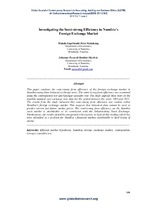| dc.contributor.author | Sheefeni, Johannes Peyavali Sheefeni | |
| dc.contributor.author | Mabakeng, Mukela Engelbrecht Peter | |
| dc.date.accessioned | 2021-03-08T13:00:46Z | |
| dc.date.available | 2021-03-08T13:00:46Z | |
| dc.date.issued | 2014 | |
| dc.identifier.citation | Sheefeni, J. P. S., & Mabakeng, M.E. P. (2014). Investigating the semi-strong efficiency in Namibia’s foreign exchange market. Global Journal of Contemporary Research in Accounting, Auditing and Business Ethics, 1(3), 168-181 | en_US |
| dc.identifier.issn | 2311-3162 | |
| dc.identifier.uri | http://hdl.handle.net/10566/5977 | |
| dc.description.abstract | This paper analyses the semi-strong form efficiency of the foreign exchange market in
Namibia using three bilateral exchange rates. The semi-strong form efficiency was examined
using the cointegration test and Granger causality test. The study applied these tests on the
monthly nominal spot exchange rate data for the period between the years 1993 and 2011.
The results from the study indicated that semi-strong form efficiency was evident within
Namibia’s foreign exchange market. This suggests that historical data cannot be used to
predict current and future market prices. The semi-strong form efficiency on the Namibia
stock market is attributable to its correlation with the Johannesburg Stock Exchange.
Furthermore, the results should be interpreted with caution; in light of thin trading which has
been identified as a problem for Namibia’s financial markets attributable to dual-listing of
stocks | en_US |
| dc.language.iso | en | en_US |
| dc.publisher | Global Business Research Journals | en_US |
| dc.subject | Efficient market hypothesis | en_US |
| dc.subject | Namibia | en_US |
| dc.subject | Foreign exchange market | en_US |
| dc.subject | Cointegration | en_US |
| dc.subject | Granger causality test | en_US |
| dc.title | Investigating the semi-strong efficiency in Namibia’s foreign exchange market | en_US |
| dc.type | Article | en_US |

